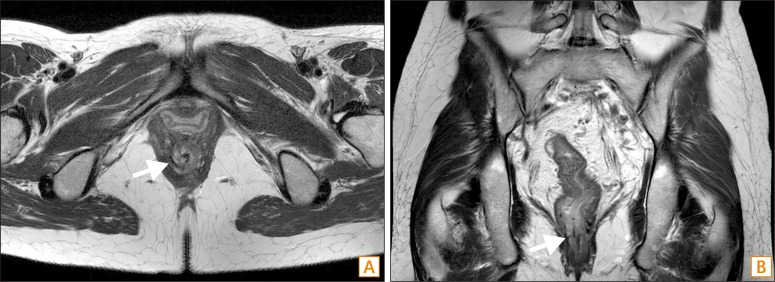Intest Res.
2016 Jul;14(3):285-288. 10.5217/ir.2016.14.3.285.
High grade anorectal stricture complicating Crohn's disease: endoscopic treatment using insulated-tip knife
- Affiliations
-
- 1Division of Gastroenterology, Department of Internal Medicine, Chonbuk National University College of Medicine and Hospital, Jeonju, Korea. soo@cuh.co.kr
- KMID: 2354972
- DOI: http://doi.org/10.5217/ir.2016.14.3.285
Abstract
- Endoscopic treatments have emerged as an alternative to surgery, in the treatment of benign colorectal stricture. Unlike endoscopic balloon dilatation, there is limited data on endoscopic electrocautery incision therapy for benign colorectal stricture, especially with regards to safety and long-term patency. We present a case of a 29-year-old female with Crohn's disease who had difficulty in defecation and passing thin stools. A pelvic magnetic resonance imaging scan, gastrograffin enema, and sigmoidoscopy showed a high-grade anorectal stricture. An endoscopic insulated-tip knife incision was successfully performed to resolve the problem. From our experience, we suggest that endoscopic insulated-tip knife treatment may be a feasible and effective modality for patients with short-segment, very rigid, fibrotic anorectal stricture.
MeSH Terms
Figure
Reference
-
1. Brochard C, Siproudhis L, Wallenhorst T, et al. Anorectal stricture in 102 patients with Crohn's disease: natural history in the era of biologics. Aliment Pharmacol Ther. 2014; 40:796–803. PMID: 25109493.
Article2. Rieder F, Zimmermann EM, Remzi FH, Sandborn WJ. Crohn's disease complicated by strictures: a systematic review. Gut. 2013; 62:1072–1084. PMID: 23626373.
Article3. Krieger BR, Steinhagen RM. Perianal Crohn's disease - A surgical perspective. Semin Colon Rectal Surg. 2012; 23:125–129.4. Keighley MR, Allan RN. Current status and influence of operation on perianal Crohn's disease. Int J Colorectal Dis. 1986; 1:104–107. PMID: 3611935.
Article5. Brooker JC, Beckett CG, Saunders BP, Benson MJ. Long-acting steroid injection after endoscopic dilation of anastomotic Crohn's strictures may improve the outcome: a retrospective case series. Endoscopy. 2003; 35:333–337. PMID: 12664391.
Article6. Thienpont C, D'Hoore A, Vermeire S, et al. Long-term outcome of endoscopic dilatation in patients with Crohn's disease is not affected by disease activity or medical therapy. Gut. 2010; 59:320–324. PMID: 19840991.
Article7. Kerkhof M, Dewint P, Koch AD, van der Woude CJ. Endoscopic needle-knife treatment of refractory ileo-ascending anastomotic stricture. Endoscopy. 2013; 45(Suppl 2):E57–E58. PMID: 23526517.
Article8. DiSario JA, Pedersen PJ, Bichiş-Canoutas C, Alder SC, Fang JC. Incision of recurrent distal esophageal (Schatzki) ring after dilation. Gastrointest Endosc. 2002; 56:244–248. PMID: 12145604.
Article9. Brandimarte G, Tursi A. Endoscopic treatment of benign anastomotic esophageal stenosis with electrocautery. Endoscopy. 2002; 34:399–401. PMID: 11972272.
Article10. Brandimarte G, Tursi A, Gasbarrini G. Endoscopic treatment of benign anastomotic colorectal stenosis with electrocautery. Endoscopy. 2000; 32:461–463. PMID: 10863912.
Article11. Hagiwara A, Togawa T, Yamasaki J, Shirasu M, Sakakura C, Yamagishi H. Endoscopic incision and balloon dilatation for cicatricial anastomotic strictures. Hepatogastroenterology. 1999; 46:997–999. PMID: 10370654.12. Ibarguen-Secchia E. Endoscopic pyloromyotomy for congenital pyloric stenosis. Gastrointest Endosc. 2005; 61:598–600. PMID: 15812419.
Article13. Baron TH. Snares, knives, and scissors. Tech Gastrointest Endosc. 2006; 8:22–27.
Article14. Hyun JJ, Chun HJ, Keum B, et al. Weblike stenosis due to gastroesophageal reflux disease, treated with an insulation-tipped diathermic knife-2 (IT-2). Endoscopy. 2010; 42(Suppl 2):E110. PMID: 20306396.
Article15. Lee SS, Hwang ST, Jang NG, et al. A case of congenital duodenal web causing duodenal stenosis in a down syndrome child: endoscopic resection with an insulated-tip knife. Gut Liver. 2011; 5:105–109. PMID: 21461083.
Article16. Koh KH, Kim SJ, Park S, et al. Two cases of central airway obstruction treated with an insulation-tipped diathermic knife-2. Korean J Med. 2014; 86:755–760.
Article
- Full Text Links
- Actions
-
Cited
- CITED
-
- Close
- Share
- Similar articles
-
- A Case of Doudenal Diaphragm in an Adult Treated with Endoscopic Membranotomy using Insulated Tip Electrosurgical Knife
- Endoscopic Mucosal Resection Using Insulated-tip Electrosurgical Knife
- An Intractable Caustic Esophageal Stricture Successfully Managed with Sequential Treatment Comprising Incision with an Insulated-Tip Knife, Balloon Dilation, and an Oral Steroid
- Use of an insulated tip knife in the management of a common foreign body in a child
- Two Cases of Electrocautery Incision Therapy Using an Insulated-tip Knife for Treatment of Symptomatic Benign Short-segment Colonic Stenosis Following Colonic Resection




